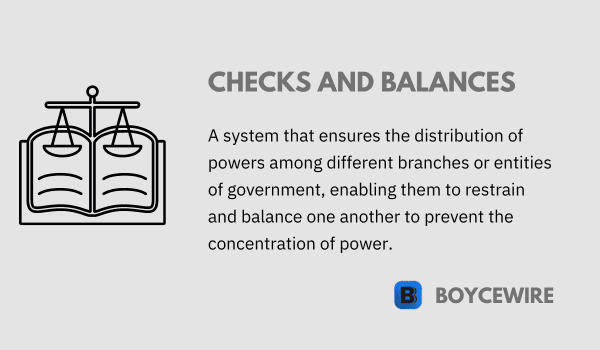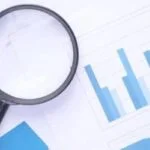Checks and Balances: How it Works & Why it’s Important

What are Checks and Balances?
The checks and balances system is a foundational concept in many democratic governments worldwide, particularly notable in the United States’ governance structure. Developed to prevent a single entity or group from amassing excessive power, checks and balances create a system of mutual oversight and shared responsibility among distinct branches of government.
This mechanism fosters a delicate balance, ensuring each branch can function effectively without dominating the others. This article will explore the theoretical foundation of checks and balances, their implementation in the United States Constitution, how they function in practice, and their significance in modern democracies. We will also delve into some of the criticisms and limitations of this system, emphasizing its dynamic and evolving nature in response to societal changes and challenges.
Key Points
- Checks and balances refer to a system in which the powers of different branches or entities of government are balanced and restrained by the others.
- The purpose of checks and balances is to prevent the concentration of power and to ensure accountability within a government.
- Checks and balances work by dividing powers among different branches or institutions of government, such as the executive, legislative, and judicial branches.
- Each branch or institution has certain powers and authorities that can be used to check and limit the actions of the other branches.
The Foundations of the Checks and Balances System
The foundations of the checks and balances system can be traced back to ancient Greece and Rome, but its most famous implementation is in the Constitution of the United States. The framers of the U.S. Constitution, influenced by the political philosophy of the Enlightenment, particularly the writings of Montesquieu, sought to create a government structure that could prevent the accumulation of absolute power in any one branch or person.
The Enlightenment thinkers were greatly concerned with the potential abuses of power that could arise in a government. Their solution was to separate the powers of the government into distinct branches, each with its own responsibilities and powers. This separation of powers laid the groundwork for the system of checks and balances, where each branch of government can limit and control the powers of the others.
In the U.S. Constitution, this system is delineated across three branches of government: the Executive (headed by the President), the Legislative (comprising the Senate and the House of Representatives), and the Judicial (consisting of the Supreme Court and other federal courts). Each of these branches possesses unique powers that enable them to ‘check’ the others, thereby creating a balance of power.
For example, while the Legislative branch has the power to make laws, the Executive branch has the authority to veto those laws. In turn, the Judicial branch has the authority to review these laws and strike them down if they’re found to be unconstitutional. Similarly, the President (Executive) can be impeached by the Legislative branch, and the judges for the Judicial branch are appointed by the Executive and approved by the Legislative.
This intricate system was designed to promote cooperation and compromise, prevent arbitrary decision-making, and protect individual liberties by ensuring no single entity becomes too powerful.
Checks and Balances in the United States Constitution
The United States Constitution explicitly lays out the system of checks and balances between its three branches: the Executive, the Legislative, and the Judicial. This system ensures that each branch has unique powers that can limit or check the powers of the other branches, preventing the accumulation of excessive power in any one branch and maintaining a balance of power within the government.
-
Executive Branch (The President and the administration):
The Executive branch, headed by the President, has the power to veto legislation passed by Congress, essentially blocking it from becoming law. The President also has the power to appoint federal judges and Supreme Court Justices, subject to Senate approval. The Executive branch, through the Department of Justice, also has the power to enforce federal laws, which includes interpreting how these laws should be applied.
-
Legislative Branch (Congress, consisting of the Senate and the House of Representatives):
The Legislative branch, composed of the Senate and the House of Representatives, is the law-making branch of government. They can check the power of the Executive by overriding presidential vetoes with a two-thirds majority vote in both houses. Congress also controls the budget and has the power to approve or reject the appointments of federal judges and Supreme Court Justices made by the President. In extreme cases, the Legislative branch has the power to impeach the President and remove them from office.
-
Judicial Branch (The Supreme Court and other federal courts):
The Judicial branch, headed by the Supreme Court, interprets the Constitution and has the power of judicial review. This means they can declare laws passed by Congress or executive actions by the President as unconstitutional, effectively invalidating them. The federal courts also have the power to interpret laws and hear cases that challenge the legality of actions taken by the other branches of government.
Overall, the system of checks and balances in the U.S. Constitution is a complex web of interbranch interactions that aim to ensure no single branch of government becomes too powerful, preserving democracy and the rule of law.
Checks and Balances in the United States Government
The system of checks and balances in the United States’ government has been in action since the country’s founding. Here are a few notable examples:
1. Presidential Veto
One of the most direct examples of checks and balances is the presidential veto. For instance, in 2015, President Barack Obama vetoed the Keystone XL Pipeline Act, which had been passed by the Republican-led Congress. This act exemplifies the executive branch’s power to check the legislative branch.
2. Supreme Court Rulings
The Supreme Court has often acted to check the powers of both the executive and legislative branches through its power of judicial review. A landmark case is “Marbury v. Madison” (1803), where the Supreme Court asserted its power to declare acts of Congress unconstitutional, setting a precedent for judicial review. More recently, in 2012, the Supreme Court upheld the constitutionality of the Affordable Care Act (ACA) in the case “National Federation of Independent Business v. Sebelius”, effectively checking the powers of both the legislative and executive branches.
3. Congressional Override of Presidential Veto
Congress has the power to override a presidential veto with a two-thirds majority in both houses. This has occurred multiple times in U.S. history. An example is the Civil Rights Act of 1964. President Lyndon B. Johnson signed it into law, but if he had vetoed it, Congress had enough votes for an override.
4. Impeachment Proceedings
Impeachment is a significant check held by Congress over the executive and judicial branches. The House of Representatives impeached President Bill Clinton in 1998 and President Donald Trump in 2019 and again in 2021. However, the Senate did not reach the necessary two-thirds majority to convict in any of these cases.
5. Confirmation of Appointments
The Senate’s power to confirm appointments made by the President serves as a check on executive power. An example is the Senate’s rejection of President Ronald Reagan’s nomination of Robert Bork to the Supreme Court in 1987.
Criticisms and Limitations of Checks and Balances
While the system of checks and balances is a cornerstone of the U.S. Constitution, it is not without its critics. Here are some commonly cited criticisms and limitations:
-
Gridlock:
One of the most common criticisms is that the system can lead to gridlock, where the government becomes so balanced that it becomes difficult for it to act decisively or swiftly. When political parties are evenly split or when they prioritize partisanship over compromise, it can be challenging to pass new laws or make significant changes. This was evident in the multiple government shutdowns that have occurred due to Congress’s inability to agree on a budget.
-
Accumulation of Executive Power:
Despite the checks and balances in place, some critics argue that the executive branch has accrued too much power over time. For example, through the use of executive orders and the expansive role of the executive in matters of foreign policy and national security, some argue that the balance of power has tipped in favor of the presidency.
-
Judicial Overreach:
The Supreme Court’s power of judicial review—while not explicitly mentioned in the Constitution—has been criticized as judicial overreach or “legislating from the bench.” Critics argue that unelected judges can effectively make law by interpreting the Constitution in ways that have broad policy implications.
-
Role of Political Parties:
The framers of the Constitution did not anticipate the role political parties would come to play in the U.S. government. The rise of parties has sometimes resulted in partisanship that can disrupt the intended balance of power, with party loyalty influencing the checks and balances system.
-
Inefficiency:
While checks and balances are designed to prevent misuse of power, the system can also lead to inefficiency. Decision-making processes can be slow, as approval may be needed from multiple branches. This can be particularly problematic in times of crisis when quick responses are necessary.
Despite these criticisms and limitations, many argue that the benefits of preventing tyranny and protecting individual rights outweigh the potential inefficiencies and disagreements that can arise within the system of checks and balances.
Importance of Checks and Balances
The system of checks and balances is integral to the functioning of the U.S. government and many other democracies around the world. Its importance can be distilled into the following key points:
-
Preventing Tyranny:
At its core, the system of checks and balances is designed to prevent any one branch of government from gaining too much power and potentially establishing a tyrannical rule. By distributing authority and creating mechanisms for each branch to limit the powers of the others, the system guards against the concentration of power.
-
Promoting Fair Governance:
Checks and balances promote fair governance by ensuring that no single decision-making authority goes unchecked. This helps prevent arbitrary or biased decisions and promotes fairness and equality in governance.
-
Encouraging Collaboration and Compromise:
The need for different branches of government to agree on certain matters encourages collaboration and compromise. This can lead to more balanced and well-considered laws and policies.
-
Accountability:
The system of checks and balances creates multiple opportunities for accountability. Each branch is answerable to the others, and this mutual accountability helps maintain integrity and honesty in government.
-
Protecting Individual Rights:
By preventing any one branch from wielding absolute power, the system of checks and balances protects individual liberties and rights. This is crucial in a democratic society where the rights of the individual are paramount.
-
Enhancing Public Trust:
The transparency inherent in a system of checks and balances can help to enhance public trust in government. When citizens can see that power is distributed and no single entity has unchecked control, they are likely to have greater confidence in their governance structures.
FAQs
Checks and balances refer to a system in which the powers of different branches or entities of government are balanced and restrained by the others, preventing any one branch from becoming too powerful.
Checks and balances are important because they help safeguard against abuses of power and ensure accountability within a government. They provide a system of oversight and prevent the concentration of power in any single branch or individual.
Checks and balances work by dividing powers among different branches or institutions of government, such as the executive, legislative, and judicial branches. Each branch has certain powers and authorities that can be used to check and limit the actions of the other branches.
The purpose of the separation of powers is to ensure that no single branch of government has absolute control. The executive branch enforces laws, the legislative branch makes laws, and the judicial branch interprets laws. This separation helps maintain a balance of power and prevents the abuse of authority.
About Paul
Paul Boyce is an economics editor with over 10 years experience in the industry. Currently working as a consultant within the financial services sector, Paul is the CEO and chief editor of BoyceWire. He has written publications for FEE, the Mises Institute, and many others.

Further Reading
 Determinants of Supply - Determinants of supply are the factors that influence the quantity of goods or services that producers are willing and able…
Determinants of Supply - Determinants of supply are the factors that influence the quantity of goods or services that producers are willing and able…  Confidence Interval - A confidence interval is a range of values that provides an estimated range of plausible values for a population parameter,…
Confidence Interval - A confidence interval is a range of values that provides an estimated range of plausible values for a population parameter,…  Floating Exchange Rate: Definition, Pros, Cons & Example - A floating exchange rate is where the value of a nation's currency, when compared to another, is determined by supply…
Floating Exchange Rate: Definition, Pros, Cons & Example - A floating exchange rate is where the value of a nation's currency, when compared to another, is determined by supply… 